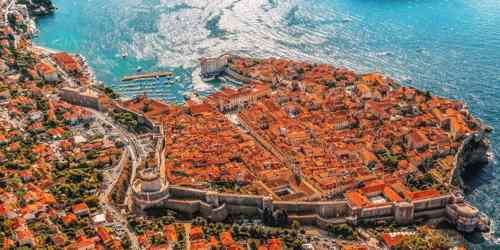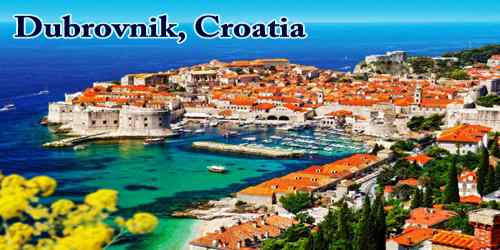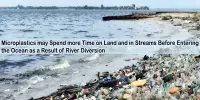Dubrovnik (Croatian: dǔbroːʋniːk; historically (Italian) Ragusa) is a port of Dalmatia and a city on the Adriatic Sea in southern Croatia. It is one of the most prominent tourist destinations in the Mediterranean Sea, a seaport and the center of Dubrovnik-Neretva County. Its total population is 42,615 (census 2011). In 1979, the city of Dubrovnik joined the UNESCO list of World Heritage Sites.
The city sits on the coast of the Adriatic Sea in southern Croatia with a population that exceeds just over 40,000. It is usually regarded as the most picturesque city on the Dalmatian coast and is referred to as the “Pearl of the Adriatic.” The city has become a summer hotspot for tourists, but it’s easy to see why it has become one of the best places to visit in Europe. The city’s Old Town is impressively preserved and sits protected by its high surrounding walls, which visitors can walk atop of for stellar views of the city and the turquoise sea. A number of islands are within reach for an easy one-day boat trip, or visitors can spend the day lounging on one of Dubrovnik’s picturesque beaches.
The prosperity of the city was historically based on maritime trade; as the capital of the maritime Republic of Ragusa, it achieved a high level of development, particularly during the 15th and 16th centuries, as it became notable for its wealth and skilled diplomacy.
In 1991, after the break-up of Yugoslavia, Dubrovnik was besieged by Serbian and Montenegrin soldiers of the Yugoslav People’s Army (JNA) for seven months and suffered significant damage from shelling. After repair and restoration works in the 1990s and early 2000s, Dubrovnik re-emerged as one of the top tourist destinations in the Mediterranean.

History of the city –
The city was founded about 614 as Rausa, or Ragusium, by Roman refugees fleeing the Slav and Avar sack of Epidaurus, just to the southeast. A colony of Slavs soon joined the Romans there, and from an early date the city formed a link between two great civilizations. After the fall of Rome, Dubrovnik was ruled by the Byzantine Empire. From the 9th to the 12th century Dubrovnik defended itself against foreign powers, and in the period 1205 to 1358 it acknowledged Venetian suzerainty, though it retained much of its independence.
The name Dubrovnik of the Adriatic city is first recorded in the Charter of Ban Kulin (1189). It is mostly explained as dubron, a Celtic name for water (Gaulish dubron, Irish dobar, Welsh dŵr, dwfr, Cornish dofer), akin to the toponyms Douvres, Dover, and Tauber; or originating from a Proto-Slavic word dǫbъ meaning ‘oak’. The term dubrovnik means the ‘oakwood’, as in all other Slavic languages the word dub, dàb, means ‘oak’ and dubrava, dąbrowa means the ‘oakwood’.
The historical name Ragusa is recorded in the Greek form Ῥαούσιν (Rhaousin, Latinized Ragusium) in the 10th century. It was recorded in various forms in the medieval period, Rausia, Lavusa, Labusa, Raugia, Rachusa. Various attempts have been made to etymologize the name. Suggestions include derivation from Greek ῥάξ, ῥαγός “grape”; from Greek ῥώξ, ῥωγός “narrow passage”; Greek ῥωγάς “ragged (of rocks)”, ῥαγή (ῥαγάς) “fissure”; from the name of the Epirote tribe of the Rhogoi, from an unidentified Illyrian substrate. A connection to the name of Sicilian Ragusa has also been proposed. Putanec (1993) gives a review of etymological suggestion, and favors an explanation of the name as pre-Greek (“Pelasgian”), from a root cognate to Greek ῥαγή “fissure”, with a suffix -ussa also found in the Greek name of Brač, Elaphousa.
The city-republic was liberal in character, affording an asylum to refugees of all nations one of them, according to legend, was King Richard I (the Lionheart) of England, who landed on the offshore island of Lokrum in 1192 on his return from the Crusades and abolishing the slave trade in 1418, and by means of the treaty and tribute it enlarged its territory along the Dalmatian coast.
In 1272 the city received a statute that incorporated Roman and local practices. Situated at the seaward end of overland trade routes to Byzantium and the Danube region, it became a great mercantile power. Ragusan land trade flourished throughout the Balkans.
In 1420, when Dalmatia was sold to Venice, Dubrovnik remained a free city in all but name. For centuries the people of Dubrovnik were able to preserve their city-republic by skillful maneuvering between East and West. A strategic treaty with Turkey protracted Dubrovnik’s liberty and maintained the opportunity for a major trading role between the Ottoman Empire and Europe. In the 16th century, Dubrovnik traded with India and the Americas (the republic was among the first to recognize the independence of the United States in the late 18th century), and the city contributed ships to Spain in 1588 for the Armada’s abortive invasion of England.
A great flourishing of art and literature, in the 15th–17th century, earned it the title of “the South Slav Athens.” For the first time in the history of the South Slavs, the language of the people was introduced into literature. The city’s literary history, however, never compared to its maritime and mercantile achievements.
The Republic gradually declined due to a combination of a Mediterranean shipping crisis and the catastrophic earthquake of 1667 which killed over 5,000 citizens, leveled most of the public buildings, and, consequently, negatively affected the well-being of the Republic. The Sponza and the Rector’s palace were the only buildings that survived the natural disaster. In 1699, the Republic was forced to sell two mainland patches of its territory to the Ottomans in order to avoid being caught in the clash with advancing Venetian forces. Today this strip of land belongs to Bosnia and Herzegovina and is that country’s only direct access to the Adriatic. A highlight of Dubrovnik’s diplomacy was the involvement in the American Revolution.
The final coup de grâce was dealt with by Napoleon, whose troops entered Dubrovnik in 1808 and announced the end of the republic. The Vienna Congress of 1815 ceded Dubrovnik to Austria; though the city maintained its shipping, it succumbed to social disintegration. Following WWI the city started to develop its tourist industry, swiftly becoming Yugoslavia’s leading attraction.
Dubrovnik was caught in the crosshairs of the war that followed Croatia’s declaration of independence in 1991. For no obvious military or strategic reason, Dubrovnik was pummelled with some 2000 shells in 1991 and 1992 by the Yugoslav military, suffering considerable damage and loss of life. All of the damaged buildings have now been restored. Most of the reconstruction work was done between 1995 and 1999. The inflicted damage can be seen on a chart near the city gate, showing all artillery hits during the siege, and is clearly visible from high points around the city in the form of the more brightly colored new roofs.

Geography and Sites of the city –
The city walls, mostly a double line, have long been a source of pride for Dubrovnik. The walls were erected by the 16th century and run a course of about 6,365 feet (1,940 meters) in length, encircling most of the old city, and reach a maximum height of about 80 feet (25 meters). Along its course and within the walls lie several towers and fortresses, as well as numerous historic monuments. Beyond the walls are many villas surrounded by gardens. The basic city plan dates from 1292 when the port was rebuilt following a fire. The Stradun, or main street, with beautiful late-Renaissance houses on each side, runs along a valley that, until 1272, was a marshy channel dividing the Latin island of Ragusa from the forest settlement of Dubrovnik. No motor vehicles are allowed inside the walls, and, except for the Stradun, the old city is a maze of picturesque narrow streets, many of them steep and twisting. The walls of Dubrovnik have also been a popular filming location for the fictional city of King’s Landing in the HBO television series, “Game of Thrones”.

Dubrovnik has a borderline humid subtropical (Cfa) and Mediterranean climate (Csa) in the Köppen climate classification, since only one summer month has less than 40 mm (1.6 in) of rainfall, preventing it from being classified as solely humid subtropical or Mediterranean. Dubrovnik has hot, muggy, moderately dry summers and mild to cool wet winters. The bora wind blows cold gusts down the Adriatic coast between October and April, and thundery conditions are common all the year-round, even in summer, when they interrupt the warm, sunny days. The air temperatures can slightly vary, depending on the area or region. Typically, in July and August daytime maximum temperatures reach 28 °C (82 °F), and at night drop to around 23 °C (73 °F). In Spring and Autumn maximum temperatures are typically between 20 °C (68 °F) and 28 °C (82 °F). Winters are among the mildest of any Croatian city, with daytime temperatures around 13 °C (55 °F) in the coldest months. Snow in Dubrovnik is very rare.
Two 14th-century convents stand at the ends of the city; the Franciscans guarded the western gate, while the Dominicans kept eastern. The Rector’s Palace, dating from the 15th century and built in the late Gothic style, was the seat of government of the Dubrovnik Republic and is a masterpiece of Dalmatian architecture. Other notable structures include numerous fortresses (such as Lovrijenac, which sits atop a cliff); a 16-sided fountain and bell tower, both of which originally dates from the 15th century; and a 15th-century Jewish synagogue that is among the oldest in Europe. The island of Lokrum is famous for its gardens and orange groves, and it also includes a fortress and monastery.
The city boasts many old buildings, such as the Arboretum Trsteno, the oldest arboretum in the world, which dates back to before 1492. Also, the third-oldest European pharmacy and the oldest still in operation, having been founded in 1317, is in Dubrovnik, at the Little Brothers monastery.
In history, many Conversos (Marranos) were attracted to Dubrovnik, formerly a considerable seaport. In May 1544, a ship landed there filled exclusively with Portuguese refugees, as Balthasar de Faria reported to King John. Another admirer of Dubrovnik, George Bernard Shaw, visited the city in 1929 and said: “If you want to see heaven on earth, come to Dubrovnik.”
Dubrovnik is home to many fine museums. The Museum of Dubrovnik, sited in the Rector’s Palace, contains extensive collections of furniture and uniforms. The inventory of Dubrovnik’s old pharmacy (founded in the 14th century), jewelry, embroideries, and paintings are displayed in the Franciscan monastery. The Maritime Museum, established in 1941 and located in a former fortress, chronicles the city’s seafaring past. The Dubrovnik State Archives, with manuscripts in numerous languages and some dating to 800 years ago, are located in the Sponza Palace (formerly a mint). There are also archaeological, ethnographic, and theatrical museums. A summer arts festival featuring theatre and music and other annual festivals attract many tourists to the scenic city.
In the bay of Dubrovnik is the 72-hectare (180-acre) wooded island of Lokrum, where according to legend, Richard the Lionheart, King of England, was cast ashore after being shipwrecked in 1192. The island includes a fortress, botanical garden, monastery, and naturist beach. Among the many tourist destinations are a few beaches. Banje, Dubrovnik’s main public beach, is home to the Eastwest Beach Club. There is also Copacabana Beach, a stony beach on the Lapad peninsula, named after the popular beach in Rio de Janeiro.
Direct rail lines connected Dubrovnik to surrounding countries, but there are only indirect links with other Croatian cities. From its harbor at nearby Gruž, ships ply to other Dalmatian ports and to Italy. The port and tourism are the leading factors in the city’s economy, and there are some light industries. There is an airport in nearby Čilipi with service to Zagreb, the capital of Croatia, and several major European cities.
In addition to the warm beaches and stunning scenery, Dubrovnik is a foodie’s paradise. Restaurants in the area excel in dishes using locally-caught seafood and traditional recipes including lots and lots of meat; Visitors will be pleasantly surprised by the quality of wines available in Dubrovnik and the surrounding area.
Information Sources:
















